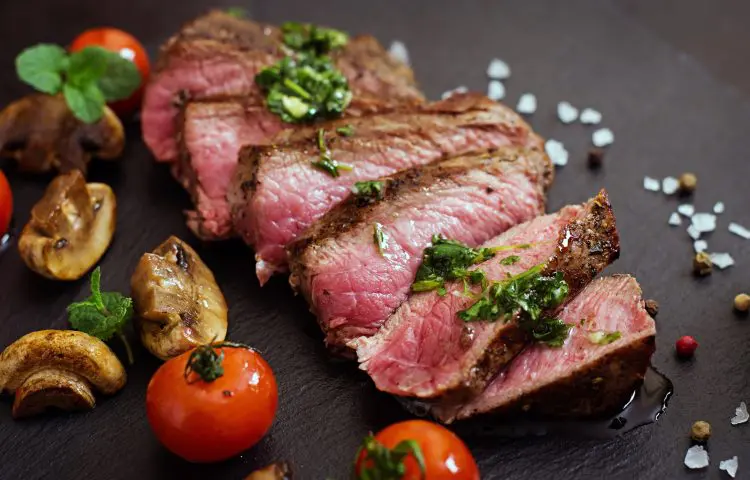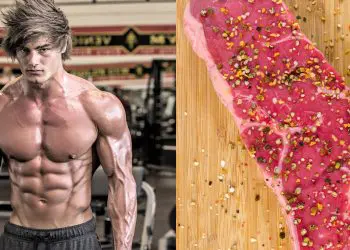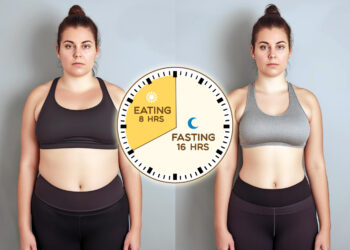From intermittent fasting to IIFYM (If It Fits Your Macros), the diet landscape is constantly shifting. Each week brings a new trend promising “miracle” results—overnight fixes, complex protocols, and rules that sound more like religious dogma than nutritional guidance. With so much noise, it’s understandable that many of us feel lost, frustrated, and unsure of where to begin. (Try our Intermittent Fasting Calculator)
The problem is not a lack of information; rather, it’s the abundance of it. Everyone and their brother is preaching the next breakthrough to lose fat or gain muscle. We often fail to realize that not all methods suit every goal. One diet might be great for fat loss, but poor for muscle gain. Another might help you lean out quickly, but leave you feeling weak in the gym. It’s time to take a pragmatic, results-driven approach. We’ll cut through the hype, return to tried-and-true principles, and show you how to eat in a way that helps you achieve real muscle growth while supporting overall health.
The Old-School Standard
Before the internet, bodybuilding magazines and local coaches were the main sources of information. The “old school” standard diet for gaining muscle mass generally revolved around a few simple principles: consume enough calories to be in a surplus, focus on high protein, moderate carbohydrates (favoring complex sources), and low to moderate fat intake. This template came from observing bodybuilders who, drugs aside, demonstrated that regular protein feedings and balanced meals worked for building serious muscle. They ate often—every 2-3 hours—ensuring a consistent supply of nutrients to support growth and recovery.
But as soon as the internet age arrived, information became more accessible—and more confusing. Suddenly, “low fat” diets were challenged by high-fat protocols, “high carb” became controversial, and meal frequency came under scrutiny. Some proclaimed that meal timing was irrelevant, while others claimed their new protocol would revolutionize muscle gain forever. The old-school approach, while seemingly simplistic, proved effective for decades. Yet people became so enamored with novelty that they overlooked the fact that bodybuilders, athletes, and fitness enthusiasts had been successfully building muscle with basic, balanced nutritional strategies for generations.
Too Much Info?
Level Up Your Fitness: Join our 💪 strong community in Fitness Volt Newsletter. Get daily inspiration, expert-backed workouts, nutrition tips, the latest in strength sports, and the support you need to reach your goals. Subscribe for free!
We now face an era of analysis paralysis. Surrounded by keto, intermittent fasting, paleo, IIFYM, carb cycling, reverse dieting, and countless other methods, it’s easy to freeze up. Instead of taking action, you might waste weeks or months researching diets, never fully committing to any one plan.
Consider the underlying principles: for fat loss, you must consume fewer calories than you burn; for muscle gain, you need a caloric surplus plus adequate protein. Trends and buzzwords often cloud these fundamental truths. Don’t get caught up in marketing gimmicks. The reality is that building muscle typically demands adequate and consistent energy intake, quality protein sources, and balanced macros. The complexity of some diets may not yield better results—it just makes eating more complicated.
This Is How You Build Muscle
Let’s return to the basics. To build muscle, you must supply your body with the resources it needs: protein to repair and build muscle tissue, carbohydrates to fuel intense training, and some dietary fat for hormone health and nutrient absorption. A small caloric surplus—approximately 300-500 calories above maintenance—is often recommended. This ensures you’re providing enough raw materials for growth without piling on unnecessary body fat.
Don’t overlook the importance of protein timing and distribution. Spreading protein intake evenly across 4-6 meals daily can support continuous muscle protein synthesis. If you’re a hardgainer or someone with a high metabolic rate, skipping meals or following a very restricted eating window can sabotage your muscle-building potential. Instead, feed your body consistently throughout the day to stay in an anabolic state.
Carbohydrates are your training fuel. Intense resistance exercise relies heavily on glycogen (stored carbohydrate) for energy. Without sufficient carbs, your performance may suffer, limiting your ability to progressively overload your muscles—an essential factor for growth. Likewise, healthy fats support hormone production (like testosterone), mood, and nutrient transport. Going ultra-low fat might impair these functions over time.
In short, muscle building isn’t just about protein shakes and chicken breasts. It’s about balancing all three macronutrients—protein, carbs, and fats—in appropriate quantities to support your training goals, body composition targets, and overall health.
Related: What is Skinny Fat and How to Fix It
Level Up Your Fitness: Join our 💪 strong community in Fitness Volt Newsletter. Get daily inspiration, expert-backed workouts, nutrition tips, the latest in strength sports, and the support you need to reach your goals. Subscribe for free!
Real-World Eating
In an ideal world, we’d all eat organic, grass-fed steak, wild-caught salmon, perfectly portioned grains, and fresh produce at every meal. But reality often dictates otherwise. Hectic schedules, tight budgets, social obligations, and travel make sticking to a rigid “perfect” meal plan difficult. The solution lies in practicality and flexibility.
Meal Prep Strategies: Prep your meals in advance, even if it’s just a day at a time. Cooking in bulk—like making a large batch of brown rice, grilling several chicken breasts, and chopping vegetables—can simplify your life. Store them in portioned containers for grab-and-go convenience.
Affordable Protein Sources: Protein powders, canned tuna, eggs, and legumes can provide budget-friendly ways to meet protein targets without resorting to expensive cuts of meat at every meal. Frozen produce and seasonal fruits and veggies can help keep costs low while still delivering essential nutrients.
Adapt to Your Environment: If you work an office job, keep protein bars or Greek yogurt at your desk. For long commutes, consider shakes or portable meals. On weekends, focus on better quality meals when you have more time to cook, so you can stay consistent even during the busy workweek.
Build Consistent Habits: Treat your meal schedule like an extension of your training routine. If you’re dedicated to your workouts, apply the same discipline to your nutrition. Eating well isn’t just about the one “perfect” meal; it’s about building long-term habits that support your goals year-round.
Old School Eating
Old school bodybuilders thrived on simplicity: consistent protein intake, ample carbs for energy, and a moderate amount of fats. They ate frequently to ensure a steady supply of nutrients, and they didn’t sweat minor details like meal timing down to the minute. Their focus was on meeting macronutrient goals, training hard, and letting time and consistency do the work.
This approach still holds water today. New school diets might tell you to fast for 16 hours or remove entire food groups, but if gaining muscle is your priority, fueling your body consistently makes sense. Eat enough protein, get in your complex carbs around training, keep fats moderate but present, and you’re laying a solid foundation for growth.
Sample Daily Structure
This sample plan focuses on practicality, not perfection. Adjust portions and ingredients based on your calorie needs, personal tastes, and budget. The idea is to show structure, meal frequency, and nutrient timing to support muscle growth and stable energy levels throughout the day.
Meal 1 (Breakfast):
- Oatmeal or cream of wheat topped with berries and a drizzle of honey
- Greek yogurt or egg whites for protein (or a couple of whole eggs if you need dietary fats)
- Optional: a cup of coffee or green tea for an energy boost
Meal 2 (Mid-Morning Snack):
- Handful of mixed nuts (almonds, walnuts, cashews) and a protein bar or low-fat cottage cheese
- Alternatively, a scoop of whey protein mixed with water if you’re short on time
Meal 3 (Lunch):
- Lean turkey, chicken, or fish sandwich on whole-grain bread
- Side of baby carrots, cherry tomatoes, or a piece of fruit for fiber and micronutrients
Meal 4 (Optional Pre-Workout):
- Small banana or an apple for easily digestible carbs
- Whole wheat sandwich with natural peanut butter for carbs and healthy fats
- A quick protein source like a small protein shake if you haven’t hit your protein target
Meal 5 (Post-Workout):
- Whey protein shake or meal replacement drink
- Fast-digesting carbs like a ripe banana or even a small sports drink if you crave something quicker
Meal 6 (Dinner):
- Lean protein (chicken breast, lean ground beef, turkey, or fish)
- Complex carbs (sweet potato, brown rice, quinoa, or whole grain pasta)
- Plenty of veggies (broccoli, spinach, mixed greens) for fiber, vitamins, and minerals
Remember, this template isn’t etched in stone. If you need more calories, increase portion sizes. If you feel sluggish, adjust your carb sources or timing. The goal is adaptability and consistency, not strict, unchangeable rules.
In Closing
Gaining muscle in the real world is less about fancy diets and more about sound nutritional principles applied consistently. It’s possible to achieve quality mass gains while working within your budget, schedule, and personal preferences. Real progress comes from balancing practicality with principles—consuming enough calories to support muscle growth, hitting your protein targets daily, ensuring sufficient carbs to fuel your workouts, and including healthy fats for overall health.
Steer clear of dogmatic diets that promise rapid miracles without effort. Building muscle and transforming your body takes time, patience, and dedication, just like mastering any skill. By focusing on proven fundamentals, evaluating your progress monthly, and making small, calculated adjustments, you can cut through the noise, embrace real-world eating, and finally get the lasting results you’ve always wanted.












